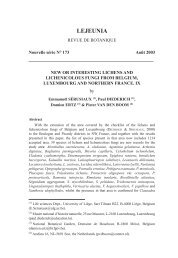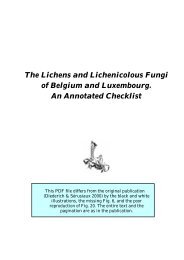A Synopsis of the Genera Skyttea, Llimoniella and - Lichens of ...
A Synopsis of the Genera Skyttea, Llimoniella and - Lichens of ...
A Synopsis of the Genera Skyttea, Llimoniella and - Lichens of ...
Create successful ePaper yourself
Turn your PDF publications into a flip-book with our unique Google optimized e-Paper software.
450 THE LICHENOLOGIST Vol. 32<br />
For a description <strong>and</strong> illustrations, see Hawksworth (1982).<br />
Host. Probably on <strong>the</strong> thallus <strong>of</strong> Micarea denigrata.<br />
Distribution. Great Britain (Scotl<strong>and</strong>), known only from <strong>the</strong> type locality.<br />
Observations. This species is characterized by <strong>the</strong> very short <strong>and</strong> narrow<br />
ascospores <strong>and</strong> <strong>the</strong> large ascomata.<br />
<strong>Llimoniella</strong> Hafellner & Nav.-Ros.<br />
Herzogia 9: 770 (1993); type: <strong>Llimoniella</strong> scabridula (Mull. Arg.) Nav.-Ros. & Hafellner.<br />
Ascomata lichenicolous, commensalistic, black, sessile to shortly pedicellate,<br />
marginate, disc plane, slightly concave or becoming convex. Exciple formed <strong>of</strong><br />
dark, thick-walled, catenate, ± isodiametric cells, <strong>the</strong> outer cells being <strong>of</strong>ten<br />
enlarged or swollen (best observed in commercial bleach), without hairs or<br />
periphysoids, reddish to purplish brown (see Fig. 7). Subhymenium hyaline.<br />
Hymenium hyaline, KI — . Epihymenium purplish. Pigments: (1) reddish to<br />
purplish brown, K+ violaceous, N - or greyish brown, in <strong>the</strong> exciple <strong>and</strong><br />
epihymenium; (2) pale olivaceous, usually hidden by <strong>the</strong> darker purplish<br />
pigment, K+ bright green, N — , in <strong>the</strong> exciple <strong>and</strong> <strong>the</strong> hymenium [pigment<br />
absent in L. adnata <strong>and</strong> L. scabridula]; (3) yellowish or orange, K —, N+<br />
bright orange, in <strong>the</strong> excipular <strong>and</strong> epihymenial gel. Paraphyses simple or<br />
apically branched, apically indistinctly swollen, without pigments, easily<br />
separating in KOH under slight pressure. Asci clavate, thin-walled, wall<br />
apically hardly thickened, KI — , normally 8-spored. Ascospores hyaline, 0-3septate,<br />
smooth, without a perispore, ellipsoid, fusiform, cylindrical or sigmoid,<br />
1-2- or multiguttulate. Conidiomata known in one single species (L.<br />
vinosa), pycnidial, globose, erumpent, wall reddish brown, apically greenish<br />
brown. Conidiogenous cells phialidic, hyaline. Conidia bacilliform, hyaline.<br />
Observations. The genus <strong>Llimoniella</strong> was originally introduced for two closely<br />
related species, L. adnata <strong>and</strong> L. scabridula. Subsequent authors added<br />
a number <strong>of</strong> related, but not congeneric species: <strong>Llimoniella</strong> fuscoatrae,<br />
L. neglecta, L. pubescens <strong>and</strong> L. stereocaulorum belong to Rhymbocarpus, <strong>and</strong><br />
L. groenl<strong>and</strong>iae nei<strong>the</strong>r belongs to Rhymbocarpus nor to <strong>Llimoniella</strong>, but<br />
to Unguiculariopsis (see under 'Excluded species')-<br />
<strong>Llimoniella</strong> is characterized by blackish, superficial apo<strong>the</strong>cia with a ±<br />
regular, smooth, striate or scabrous margin lacking hairs <strong>and</strong> a slightly concave<br />
to convex disc; an upper exciple composed <strong>of</strong> radiating, thick, catenate cells;<br />
<strong>the</strong> combination <strong>of</strong> very characteristic pigments; thin-walled asci without any<br />
hemi-amyloid reactions; <strong>and</strong> ellipsoid or elongate, straight or curved to<br />
sigmoid, 0-3-septate, 1-2- or multiguttulate, hyaline ascospores lacking a<br />
distinct perispore. For differences with Rhymbocarpus, see <strong>the</strong> identification<br />
key to lichenicolous leotialean fungi below.<br />
<strong>Llimoniella</strong> pertusariae is <strong>the</strong> only species <strong>of</strong> <strong>the</strong> genus in which we have seen<br />
living ascospores. They are multiguttulate, containing hundreds <strong>of</strong> minuscule





